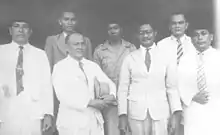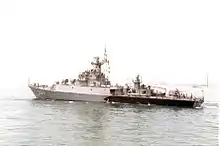Silas Papare
Silas Ayari Donrai Papare (18 December 1918 – 7 March 1978) was a Papuan–Indonesian politician and guerilla leader who is a National Hero of Indonesia.
Silas Papare | |
|---|---|
_di_Republik_Indonesia%252C_p419.jpg.webp) Papare, c. 1955 | |
| Member of People's Representative Council | |
| In office 24 March 1954 – 1960 | |
| Personal details | |
| Born | Silas Ayari Donrai Papare 18 December 1918 Serui, Yapen Islands, Dutch East Indies |
| Died | 7 March 1978 (aged 59) Jakarta, Indonesia |
| Resting place | Serui, Indonesia |
| Nationality | Indonesian |
| Political party | Indonesian Irian Independence Party |
Originating from the Yapen Islands, Papare trained and worked as a nurse prior to the Second World War, during which he organized local resistance and gathered intelligence against occupying Japanese forces. While he initially held pro-Dutch views after the war, this shifted after he was not delegated to the Malino Conference and he was influenced by Sam Ratulangi into founding the pro-Indonesian Indonesian Irian Independence Party.
Following a failed uprising against the Dutch, he was imprisoned before he left Papua in 1949, only once returning in 1950. He became a legislator between 1954 and 1960 and had participated in the Round Table Conference and the New York Agreement. Papare then began criticizing the Indonesian government's actions in Papua throughout the 1960s and was briefly arrested, though he later returned to the legislative body. He died in 1979, and was made a National Hero in 1993.
Early life and education
Silas Ayari Donrai Papare was born in the town of Serui, in the Yapen Islands, on 18 December 1918,[1] from father Musa Papare and mother Dorkas Papare.[2] At the time, Serui was one of the most exposed parts of Papua to external influences and ideas.[3] He enrolled at the local village school (Volkschool) at the age of nine and graduated in 1930, working at his parents' farm for a year before pursuing further education at a nurse school in Serui starting in 1931.[4] Papare was among some of the first to be educated in the Dutch civil servant schools in Papua, which were established in 1944.[5]
Career
After he completed school in 1935, Papare worked in Serui for some time before moving to work at the Dutch oil firm NNGPM's company hospital at Sorong in 1936, where he was a head nurse. Due to personnel shortages in Serui, Papare was reassigned there in 1940.[6][7] During the Pacific War, Papare became known as a middleman between Allied authorities and Papuans, and he sided with the Allies throughout the conflict.[3] He organized local resistance against Japanese forces around the Cenderawasih Bay area and provided intelligence to allied forces there, particularly after the Battle of Hollandia.[3][8] After the war, he was awarded the Bronze Lion by the Dutch government,[7] and was given the military rank of a sergeant.[6]
Indonesia

Immediately after the war, once Dutch authorities took over Papua's administration from the Allies, Papare became the head nurse in Serui.[7][9] At that time, his anti-Indonesian views were known, stemming from his observations of Indonesian civil servants in Papua being submissive to Japanese authorities while being repressive against Papuans.[3][7] Due to this, Dutch authorities decided to send Frans Kaisiepo instead of Papare to the Malino Conference to represent Papua in the formation of the State of East Indonesia, a decision which slighted Papare.[3][7] In June 1946, Sam Ratulangi (the Indonesian Republican Governor of Sulawesi) was exiled to Serui, where he made contact with Papare. Papare's newfound dislike for the Dutch, coupled with Ratulangi's background as a medical practitioner by trade, resulted in Papare developing pro-republican views, and by November 1946 Papare had founded the Indonesian Irian Independence Party (Partai Kemerdekaan Indonesia Irian, PKII).[3][7] Ratulangi became the general adviser to the party, which was then the largest and most active political party in West Papua.[3][10] By 17 August 1947 (the second anniversary of the proclamation of Indonesian independence), Papare had led an Indonesian flag-raising ceremony in Manokwari.[11]
Papare attained a sort of a messianic reputation locally, regarding being a savior from Dutch colonialism into an imagined utopia under Indonesian rule.[3][12] In December 1946, Papare and Marthen Indey influence the Papuan Battalion to launch a revolt against Dutch authorities, which was foiled by the Dutch due to information leakage. As a result, Papare and Indey were arrested and imprisoned in Hollandia. Papare was later moved to Biak.[13] Papare escaped and moved to Indonesia in 1949, leaving PKII leaderless.[7] In Yogyakarta in October 1949, he founded the Irian Revolutionary Body (Badan Perjuangan Irian)[14] and he later attended the Dutch–Indonesian Round Table Conference.[15] He briefly returned to Papua in 1950 as the Indonesian delegation in the Dutch–Indonesian Commission surveying the region.[16] Papare would not return to Papua, though PKII remained the dominant party in Papua throughout the 1950s.[15]

Between 1951 and 1954, Papare worked in hospitals in Jakarta, before he was appointed to the Provisional People's Representative Council on 24 March 1954 to replace the deceased Rajiman Wediodiningrat. He was reappointed to the body in 1956, as one of the delegations from Papua. He maintained his parliamentary seat until his pensioning in 1960.[9][17][18] During this period, he joined the Irian Bureau, intended to become the future provincial government for Papua. He declared an autonomous province of Papua under Indonesia in 1956, though before long the Indonesian government announced a distinct province.[19] Canadian researcher David Webster claimed that in 1961 Papare told the American Ambassador to Indonesia at the time that he intended to return to Papua to support the growing independence movement, and that he was threatened with arrest for his criticism of Sukarno, despite Papare being considered as the future Indonesian governor of Papua at that time.[17] In 1962, he was sent to New York City as part of the Indonesian delegation discussing West Papua, and the negotiations culminated with the New York Agreement.[20]
Papare was arrested in 1962,[21] though he had been released by 1963 and he returned to the parliament. Throughout the 1960s, he criticized the central government's neglect and military actions in the region, and called for the holding of an "Act of Free Choice".[22]
He died on 7 March 1978 in Jakarta, and he was buried in Serui.[23]
Legacy
Papare was declared a National Hero of Indonesia in 1993. His name was given to a Parchim-class corvette of the Indonesian Navy, a political school in Jayapura, and as a road name in Serui.[24] Additionally, an Indonesian Air Force Base in Jayapura Regency is also named after him.[25]
References
- Lumintang et al. 1997, pp. 117-119.
- Lumintang et al. 1997, p. 61.
- Chauvel 2005, pp. 70-71.
- Lumintang et al. 1997, pp. 62-63.
- Singh 2011, p. 73.
- Lumintang et al. 1997, p. 64.
- Penders 2002, p. 140.
- Lumintang et al. 1997, pp. 68-71.
- Lumintang et al. 1997, p. 65.
- Lumintang et al. 1997, p. 50.
- Singh 2011, p. 74.
- Penders 2002, p. 403.
- Lumintang et al. 1997, pp. 74-75.
- Lumintang et al. 1997, p. 88.
- Chauvel 2005, p. 72.
- Penders 2002, p. 279.
- Webster 2012, pp. 14-15.
- Tim Penyusun Sejarah (1970). Seperempat Abad Dewan Perwakilan Rakjat Republik Indonesia (PDF) (in Indonesian). Jakarta: Sekretariat DPR-GR. p. 603.
- Webster 2012, p. 8.
- Singh 2011, p. 76.
- Webster 2012, p. 20.
- Chauvel 2005, p. 99.
- Lumintang et al. 1997, p. 117.
- Mirnawati (2012). Kumpulan Pahlawan Indonesia Terlengkap [Most Complete Collection of Indonesian Heroes] (in Indonesian). Jakarta: CIF. pp. 193–194. ISBN 978-979-788-343-0.
- "Lanud Silas Papare kembali terbangkan 104 pengungsi ke Wamena". Antara News (in Indonesian). 11 October 2019. Retrieved 11 February 2020.
Bibliography
- Chauvel, Richard (2005). Constructing Papuan Nationalism : History, Ethnicity, and Adaption. Washington, D.C.: East-West Center. ISBN 1-932728-26-0.
- Lumintang, Onnie; Haryono, P. Suryo; Gunawan, Restu; Nurhajarini, Dwi Ratna (1997). Biografi Pahlawan Nasional Marthin Indey dan Silas Papare (PDF) (in Indonesian). Indonesia: Ministry of Education and Culture.
- Penders, Christian Lambert Maria (2002). The West New Guinea Debacle: Dutch Decolonisation and Indonesia, 1945-1962. University of Hawaii Press. ISBN 978-0-8248-2470-9.
- Singh, Bilveer (2011). Papua: Geopolitics and the Quest for Nationhood. Transaction Publishers. ISBN 978-1-4128-1206-1.
- Webster, David (2012). "Race, Identity and Diplomacy in the Papua Decolonization Struggle, 1949-1962". Race, Ethnicity and the Cold War: A Global Perspective. Vanderbilt University Press. ISBN 9780826518439.